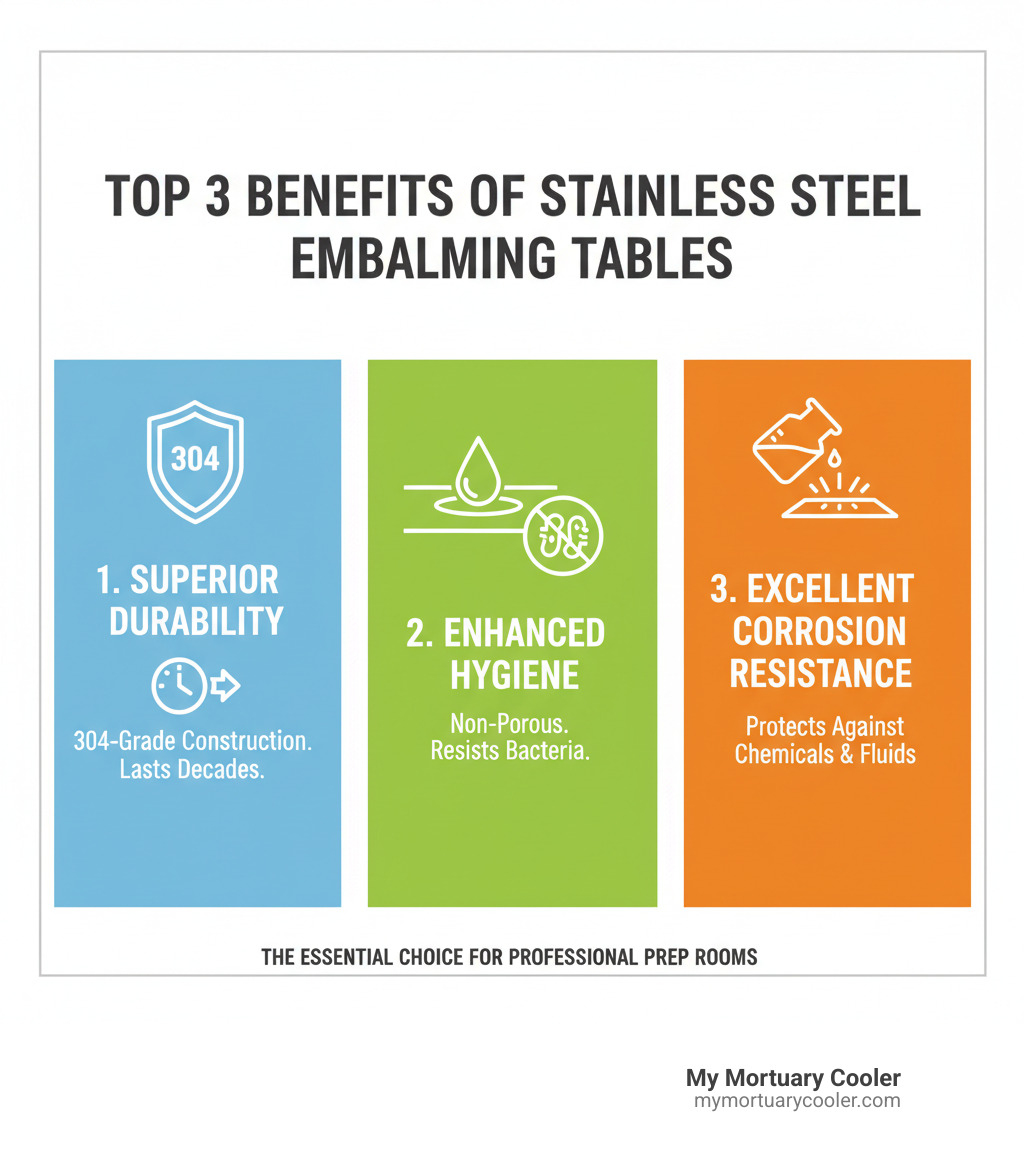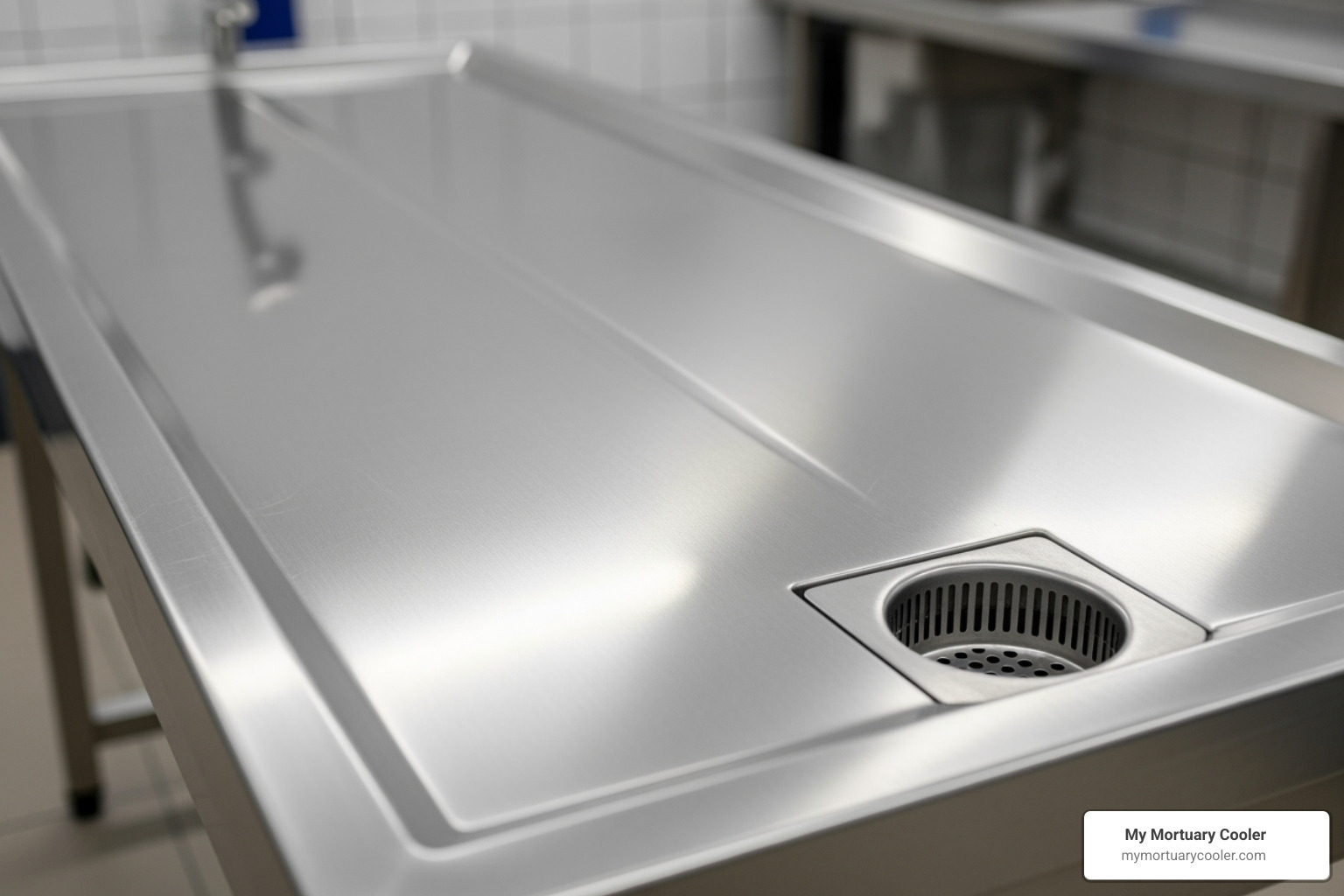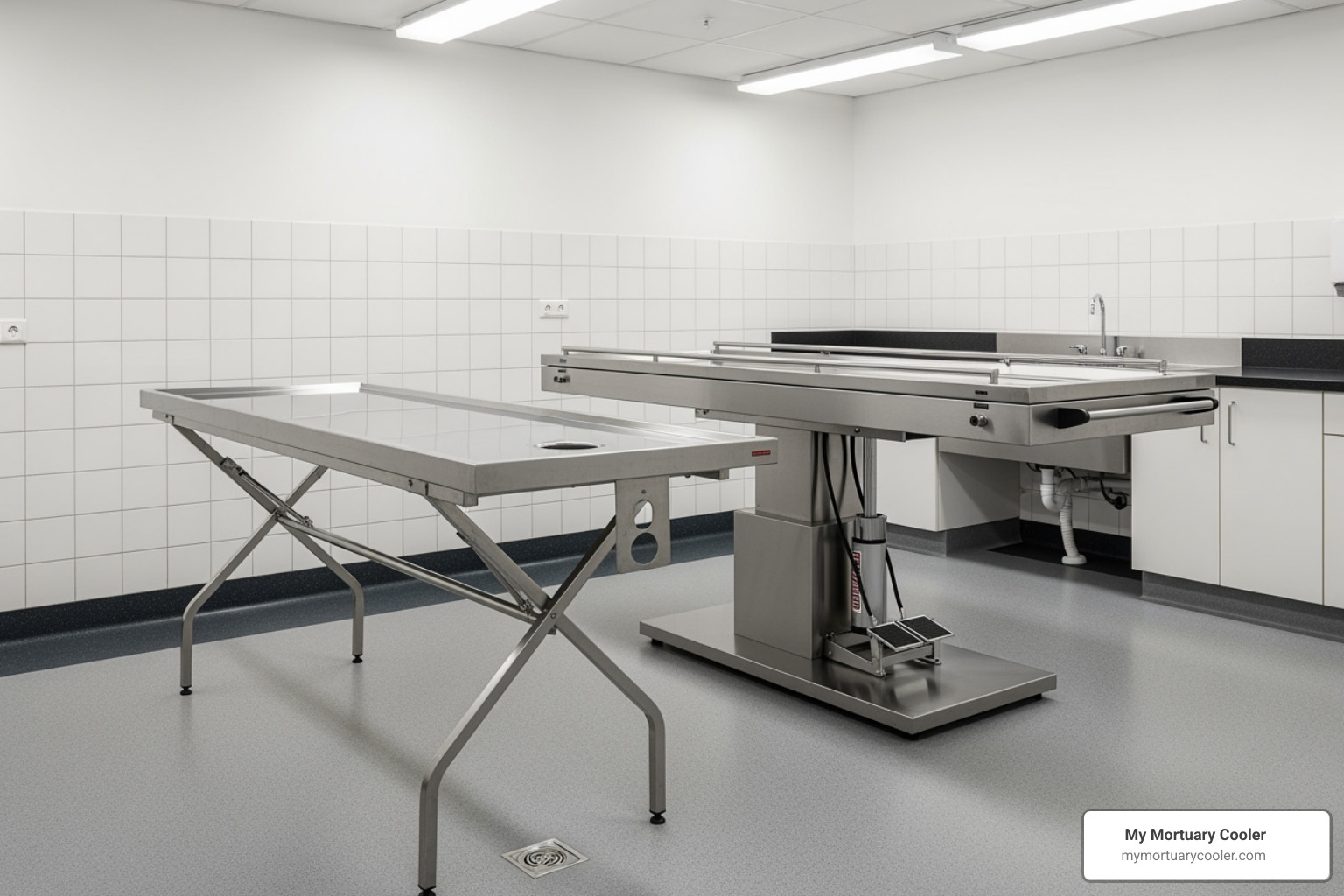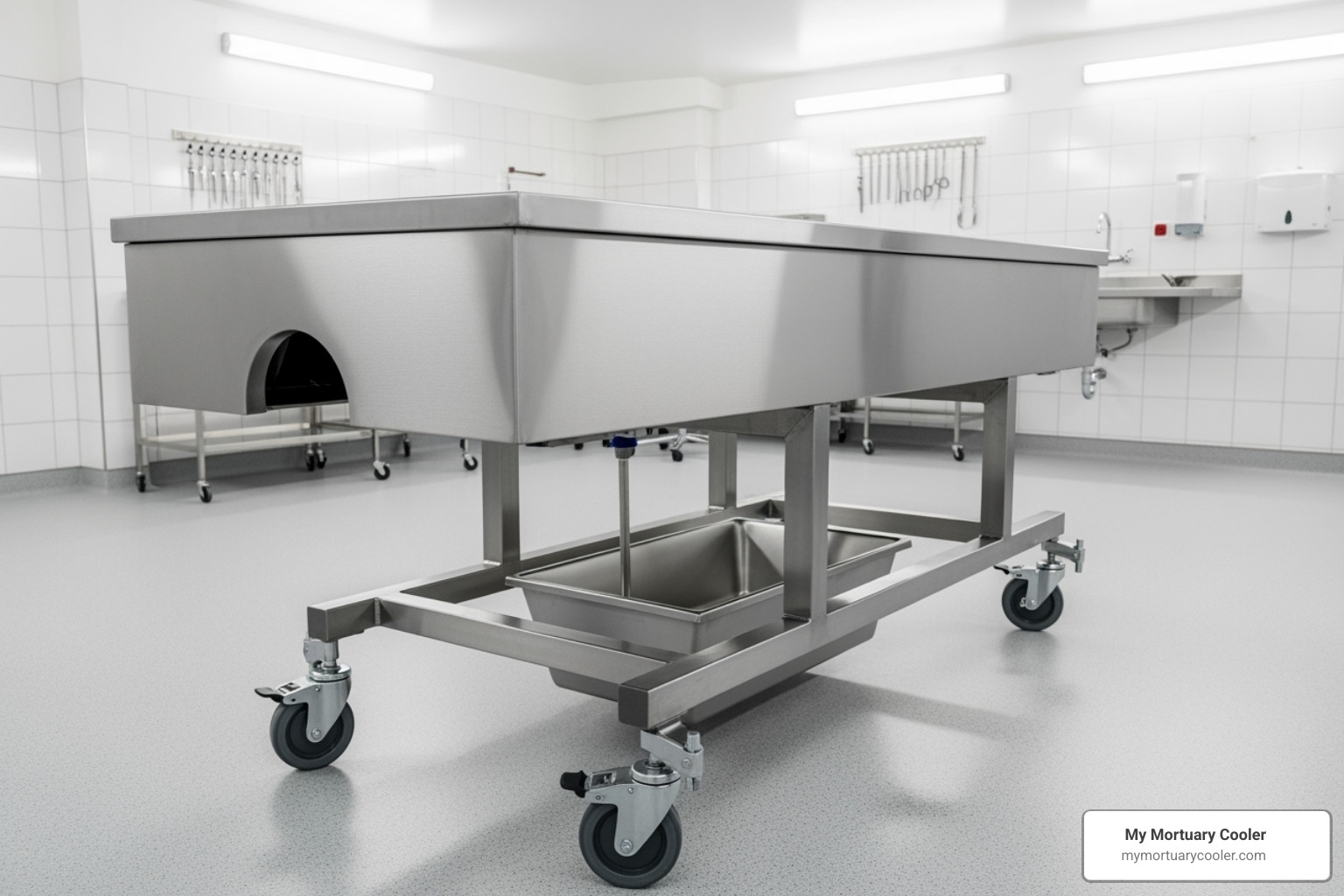Why Choosing the Right Stainless Steel Embalming Table Matters
A stainless steel embalming table is the foundation of any professional prep room, combining durability, hygiene, and functionality into one essential piece of equipment. For mortuary professionals, selecting the right table directly impacts daily operations, safety compliance, and long-term facility costs.
Quick Overview: Stainless Steel Embalming Table Essentials
- Material: 304 stainless steel construction with 14-gauge thickness
- Weight Capacity: Standard tables support 600-650 lbs, bariatric models handle up to 1,000 lbs
- Key Features: Convex drainage surface, center drain location, locking swivel castors
- Types: Folding (space-saving), hydraulic (height-adjustable), and stationary (fixed-height)
- Dimensions: Typically 80" length × 30-32" width × 30-38" adjustable height
As one funeral professional noted in customer feedback: "The quality with the hydraulic embalming table is above and beyond what I expected!" This reflects the importance of investing in well-constructed equipment that meets the demanding requirements of prep room work.
Modern stainless steel embalming tables offer features like independent height adjustment, efficient drainage systems, and mobility options that weren't available in older models. These improvements help reduce physical strain on operators while maintaining the sterile environment required for professional embalming procedures.
Whether you're upgrading existing equipment or outfitting a new facility, understanding the different types, features, and construction quality of stainless steel embalming tables will help you make an informed decision that serves your facility for years to come.

Why Stainless Steel is the Gold Standard for Prep Room Equipment
When you're running a prep room, material choice isn't just about looks—it's about creating a workspace that can handle whatever comes through your doors. Stainless steel embalming tables have earned their reputation as the industry standard because they deliver on every front that matters to mortuary professionals.
The secret lies in stainless steel's unique combination of properties. Its superior durability means your table will look and perform like new even after years of constant use. Unlike other materials that might show wear, rust, or deteriorate over time, stainless steel maintains its integrity through countless procedures and cleaning cycles.
Corrosion resistance is where stainless steel truly shines in the mortuary environment. Between the various fluids, chemicals, and rigorous disinfection protocols your equipment faces daily, lesser materials simply can't keep up. Stainless steel laughs in the face of these challenges, staying strong and stable year after year.
The non-porous surface is perhaps the most critical feature for maintaining hygiene standards. Bacteria can't take hold, liquids won't seep in, and odors won't linger. This means every cleaning cycle gets your table truly clean—not just surface clean. For busy facilities, this translates to more efficient workflows and absolute confidence in your sanitation protocols.
From a practical standpoint, the ease of sanitation can't be overstated. A quick wipe-down restores that pristine condition, letting you focus on your work instead of wrestling with complicated cleaning procedures. This efficiency adds up to significant time savings over the life of your equipment.
There's also something to be said for the professional aesthetic that stainless steel brings to your workspace. That clean, modern appearance reflects the care and respect that defines your profession. When families occasionally see your prep area, or when you're giving facility tours, that polished look speaks volumes about your standards.
Most importantly, investing in a quality stainless steel embalming table represents exceptional long-term value. While the upfront cost might be higher than alternatives, the durability and minimal maintenance requirements make it a smart financial decision that pays dividends for decades.

Understanding Stainless Steel Grades for Your Stainless Steel Embalming Table
Not all stainless steel is created equal, and knowing what goes into your embalming table can help you understand why quality matters so much. When you see 304 stainless steel listed in equipment specifications, you're looking at the gold standard for mortuary applications.
304 stainless steel contains the perfect blend of chromium and nickel that gives it exceptional resistance to the chemicals and fluids you encounter daily. This isn't just marketing speak—this specific grade can handle formaldehyde, cavity chemicals, and the various disinfectants you use without showing signs of corrosion or staining.
The 14-gauge thickness you'll find on quality table tops makes a real difference in everyday use. Lower gauge numbers mean thicker material, so 14-gauge represents serious strength. This thickness prevents the warping and flexing that can plague thinner materials, especially under heavier cases or during more intensive procedures.
Heavy-gauge tubing in the frame and legs provides the backbone that keeps everything stable. When you're working on a case, the last thing you want is any movement or instability in your work surface. This robust construction ensures your table stays rock-solid throughout any procedure.
Weld quality might seem like a minor detail, but it has major implications for both durability and sanitation. Professional-grade welds are smooth, strong, and create seamless transitions between surfaces. Poor welds create crevices where contaminants can hide, making thorough cleaning nearly impossible.
All these factors work together to impact longevity in ways that become apparent over years of use. A well-constructed table maintains its performance and appearance decade after decade, while cheaper alternatives might need replacement or major repairs within just a few years. For insights into premium construction standards, check out our guide on Premium Autopsy Lab Casework, Embalming Stations Built in the U.S..
The Importance of Quality Construction
When you're evaluating a stainless steel embalming table, construction quality separates the equipment that lasts from the equipment that becomes a headache. Sturdiness isn't just about handling weight—it's about maintaining precision and safety during every procedure.
Stability becomes critical when you consider the dynamic nature of prep room work. Whether you're repositioning during embalming or handling bariatric cases, your table needs to remain absolutely steady. Quality construction using heavy-gauge materials ensures that wobbling, flexing, or shifting never becomes a concern.
USA-made craftsmanship brings something special to the table—literally. American manufacturing standards typically mean tighter quality control, better materials sourcing, and construction techniques that prioritize long-term performance over short-term cost savings. When you see "Made in USA" on mortuary equipment, you're often looking at a product built to last decades, not just years.
Load capacity impact goes beyond the numbers on the specification sheet. A table rated for 1000 pounds isn't just about supporting that weight—it's about maintaining stability and performance even under maximum load. The engineering and materials that enable higher capacity ratings also contribute to better performance under normal working conditions.
Quality construction means every component, from the main frame down to the smallest caster, is designed to work together as a system. This attention to detail prevents the premature wear and unexpected failures that can disrupt your operations and create safety concerns.
The investment in well-constructed equipment pays dividends in reduced maintenance, longer service life, and the confidence that comes from reliable performance. For a detailed comparison of construction features across different models, explore A Comprehensive Guide to Comparing Embalming Tables.
Comparing the Main Types of Embalming Tables
Choosing the right stainless steel embalming table is like finding the perfect tool for the job – it needs to match your facility's unique needs, space constraints, and daily workflow. Not every prep room operates the same way, and thankfully, there are three main types of embalming tables designed to accommodate different situations.
Whether you're working with limited space, need maximum ergonomic flexibility, or require specialized features for specific procedures, understanding these options will help you make the best choice for your facility's long-term success.

Folding & Portable Tables
When space is tight, folding tables become your best friend. These clever designs solve one of the biggest challenges smaller funeral homes face – making the most of every square foot in their prep room.
The space-saving storage capability is remarkable. With legs that fold flat against the table surface, these tables can be stored against a wall or in a closet when not in use. This transforms your prep room from a single-purpose space into a flexible area that can serve multiple functions throughout the day.
What makes these tables even more valuable is their dual-purpose design. The MOBI Folding Embalming Table, for instance, handles both embalming and dressing procedures with ease, supporting up to 600 lbs. For facilities handling larger cases, the MOBI HD Stainless Steel Folding Dressing / Embalming Table offers an impressive 1000 lb weight capacity without sacrificing the convenience of folding storage.
The mobility factor shouldn't be overlooked either. These tables roll smoothly on sturdy castors, allowing you to set up your workspace exactly where you need it. When the procedure is complete, simply fold the legs and wheel it away. It's efficiency and flexibility rolled into one practical solution.
For funeral homes where adaptability matters most, explore our complete selection of Folding Embalming Tables by My Mortuary Cooler.
Hydraulic & Adjustable-Height Tables
Your back will thank you for choosing a hydraulic table. These tables address one of the most common occupational hazards in funeral service – the physical strain that comes from working at awkward heights and uncomfortable positions.
The ergonomic benefits are immediately noticeable. Instead of bending over a fixed-height table for hours, operators can adjust the working surface to their ideal height. This simple change dramatically reduces back strain, shoulder tension, and overall fatigue during lengthy procedures.
Modern hydraulic systems make height adjustment effortless. The MOBI Multi-Height Embalming Table features an exclusive one-hand release mechanism that allows independent height adjustment of either end. This means you can position the deceased at the perfect angle for different procedures, all while maintaining your comfortable working posture.
The typical height range spans from 30 to 38.5 inches, accommodating operators of different statures and various procedural requirements. Whether you're tall, short, or somewhere in between, the table adapts to you – not the other way around.
For facilities handling bariatric cases, the MOBI HD Stainless Steel Multi-Height Embalming Table combines ergonomic adjustability with a robust 1000 lb weight capacity. It's proof that comfort and strength can coexist beautifully.
Learn more about how these tables can transform your daily operations at Hydraulic Embalming Tables.
Stationary & Specialized Tables
Sometimes you need a table that's built like a rock – absolutely solid and designed for specific, demanding tasks. Stationary and specialized tables provide best stability for high-volume facilities or those requiring advanced features.
Fixed-height stability is their greatest strength. Without moving parts or adjustment mechanisms, these tables offer unwavering support during intensive procedures. They're the workhorses of busy prep rooms where reliability matters more than flexibility.
Ventilated tables represent the cutting edge of prep room safety. These specialized units integrate sophisticated downdraft systems that actively pull harmful fumes and airborne contaminants away from operators. Some models feature dual-side perforated exhaust connections that work with dedicated ventilation stations, creating a safer breathing environment during chemical-intensive procedures.
Many specialized tables include integrated sinks that streamline workflow considerably. These built-in wash stations, combined with sloped surfaces and efficient drainage, allow for continuous rinsing and fluid management right at your fingertips. Some designs even feature quick-connect assemblies for electrical and water systems, creating a complete embalming workstation.
For autopsy work and intensive procedures, these tables become indispensable. They're engineered to handle the most demanding tasks with features like body trays on rollers and integrated rinse jets for thorough sanitation.
When standard options won't meet your specific needs, we also create Custom Autopsy Tables custom to your exact requirements.
Key Features to Compare on a Stainless Steel Embalming Table
When you're shopping for a stainless steel embalming table, the details matter more than you might think. They all look pretty similar at first glance, but the specific features can make the difference between a table that serves you well for decades and one that becomes a daily frustration. Let's walk through the key elements that deserve your attention.

What is the typical weight capacity of a stainless steel embalming table?
Weight capacity isn't just a number on a spec sheet – it's about safety, versatility, and peace of mind. Most standard embalming tables handle between 600 to 650 pounds comfortably. Take the MOBI Folding Embalming Table at 600 lbs or the MOBI Multi-Height model that supports 650 lbs. These capacities work well for the majority of cases you'll encounter.
But here's where things get interesting. With our changing demographics, more facilities need tables that can safely accommodate bariatric individuals. That's where heavy-duty tables with 1000-pound capacity become essential. The MOBI HD Stainless Steel Multi-Height Embalming Table is a perfect example – built specifically for these situations without compromising on other features.
Why does this matter so much? Exceeding weight limits isn't just about equipment damage – though that's expensive enough. It's about preventing serious injuries to your staff and maintaining the dignity and respect every family deserves. When you're evaluating tables, always consider the needs of your community. A table that can handle any situation gives you confidence and flexibility.
The construction behind these weight ratings involves heavy-gauge tubing and reinforced joints. You're not just buying a number – you're investing in engineering that ensures stability under pressure.
Drainage Systems and Surface Design
Here's something that might surprise newcomers to the field: fluid management makes or breaks your workflow. A poorly designed drainage system turns every procedure into a messy, time-consuming ordeal. That's why smart table design focuses heavily on getting fluids where they need to go, quickly and efficiently.
The convex surface design is brilliant in its simplicity. Instead of a flat top where fluids can pool, the surface curves gently outward from the center. This means gravity does most of the work, directing fluids toward the edges and away from your work area. Many tables also feature a permanent slope – often around 3 inches – that creates a natural flow toward the drainage point.
Center drain location at the foot end has become the gold standard for good reason. It's positioned exactly where you need it most, making cleanup straightforward and preventing the backup issues you might get with side drains. Some models include a 3-inch trough with a 6-inch drain stem, which gives you even better fluid collection and prevents splashing.
This isn't just about convenience – though it certainly makes your job easier. Efficient drainage systems maintain hygiene standards, reduce contamination risks, and keep your prep room cleaner overall. For detailed insights into how these systems work in practice, check out our Embalming Table Authority Guide.
Mobility and Stability: Castors and Brakes
The ability to move your table when you need to and keep it rock-solid when you don't – that's the balance great castors provide. Quality embalming tables come with locking swivel castors that give you complete control over positioning and stability.
Swivel functionality means 360-degree movement, so you can maneuver even heavy tables into tight spaces without wrestling with them. Once you've got the table where you want it, reliable locking mechanisms ensure it stays put. There's nothing worse than a table that shifts unexpectedly during a procedure.
Castor size matters too. While 6-inch castors are standard and work well, some heavy-duty tables feature 8-inch swivel castors that handle greater loads more smoothly and steer uneven surfaces better. The larger size also tends to roll more quietly – a small detail that makes a difference in maintaining the respectful atmosphere of your facility.
The brake mechanisms deserve special attention. They need to engage securely and release easily when you need them to. Quality brakes prevent any unwanted movement, especially during transfers or when you're working at different angles around the table.
Dimensions and Ergonomics
Standard dimensions exist for good reasons, but understanding how they affect your daily work helps you make better choices. Most quality tables measure around 80 inches in length and 30 to 32 inches in width – dimensions that accommodate the vast majority of individuals while keeping the table manageable in your space.
The 80-inch length provides adequate space without making the table unwieldy, while the 30-32 inch width gives you sufficient working area from either side. The MOBI Multi-Height Embalming Table exemplifies these standards at 80" × 30".
But here's where modern tables really shine: adjustable height ranges from 30 to 38.5 inches. This isn't just a nice-to-have feature – it's essential for preventing the back pain and fatigue that come with bending over fixed-height tables for hours. The MOBI HD model adjusts from 30" to 38", letting operators of different heights find their comfortable working position.
Ergonomic design reduces physical strain significantly. When you can adjust the table to your ideal working height, you're not constantly bending, reaching, or working in awkward positions. Over time, this makes a real difference in your comfort and long-term health.
For facilities handling specialized procedures, you might want to explore our information on Adjustable Autopsy Table options that offer even more flexibility in positioning and functionality.
Frequently Asked Questions
When you're investing in a new stainless steel embalming table, it's completely normal to have questions. After all, this equipment needs to serve your facility reliably for years to come. Let's address the most common concerns we hear from funeral professionals to help you feel confident in your decision.
What is the difference between an embalming table and a dressing table?
The primary difference lies in their intended function, though many modern tables blur these lines beautifully. An embalming table is engineered specifically for the embalming process itself. You'll notice it has sophisticated drainage features - that convex surface we talked about earlier, robust center drains, and construction that can handle the constant exposure to embalming chemicals and bodily fluids.
A dressing table, by contrast, focuses on the final preparation and presentation of the deceased. While it still needs to be hygienic and easy to clean, it doesn't require the same intensive drainage system. The surface might be flatter, and the overall design prioritizes comfort and accessibility for dressing procedures.
Here's where it gets interesting: many facilities are choosing dual-purpose tables that excel at both functions. The MOBI HD Stainless Steel Folding Dressing / Embalming Table is a perfect example - it offers all the drainage and chemical resistance needed for embalming while providing the stable, clean surface ideal for dressing. This versatility is especially valuable for smaller facilities or those looking to maximize their equipment investment.
What maintenance is required for longevity and hygiene?
One of the beautiful things about stainless steel is how forgiving it is when it comes to maintenance. Your stainless steel embalming table doesn't demand complex care routines, but consistency is key.
Daily cleaning protocols are straightforward: wash the entire surface with mild detergent and warm water after each use, then follow with a thorough rinse. The non-porous surface means fluids and odors won't absorb, making this process much easier than you might expect.
For disinfection, stick with hospital-grade disinfectants that are compatible with stainless steel. Apply them according to the manufacturer's contact time recommendations, then wipe the surface completely dry to prevent water spots and maintain that professional appearance.
What should you avoid? Abrasive chemicals and scouring pads are the enemies of stainless steel. Skip the chlorine bleach (unless it's heavily diluted and immediately rinsed) and anything that might scratch the surface. These can compromise the protective layer and lead to problems down the road.
Don't forget about checking moving parts regularly. Those castors, locking mechanisms, and hydraulic components need occasional attention. A little lubrication as recommended by the manufacturer keeps everything operating smoothly. For more detailed maintenance insights, our custom autopsy tables resource offers additional guidance on caring for stainless steel surfaces.
Are there specific standards or certifications to look for?
While there isn't a single "embalming table certification" stamp, there are several quality indicators that separate professional-grade equipment from lesser alternatives.
Material grade standards are your first checkpoint. Look for explicit mention of 304 stainless steel - this isn't just marketing speak, it's a real specification that ensures proper corrosion resistance and hygienic properties. When you see specific gauge measurements like 14-gauge for the table top, that's a manufacturer telling you they're serious about construction quality.
OSHA compliance is another crucial consideration. While OSHA doesn't certify individual tables, reputable manufacturers design their equipment to help facilities meet workplace safety regulations. This shows up in features like non-slip surfaces, reliable locking brakes on castors, and ergonomic designs that protect operators from injury.
Construction quality might not come with a certificate, but it's visible in the details. Heavy-gauge tubing for frames and legs, smooth welds that won't harbor contaminants, and stated weight capacities that you can trust - these elements reflect industry best practices and a manufacturer's commitment to your safety.
The bottom line? Ask about material specifications, construction methods, and safety features. A manufacturer who can clearly explain these details is one who understands what matters in a prep room environment.
Conclusion: Choosing the Right Table for Your Facility
After diving deep into stainless steel embalming tables, you're now equipped with the knowledge to make a decision that will serve your facility well for decades to come. This isn't just about buying a piece of equipment – it's about investing in the foundation of your prep room operations.
The key considerations we've covered paint a clear picture of what matters most. Material quality starts with 304 stainless steel construction and proper gauge thickness, ensuring your table can withstand years of demanding use. Construction quality determines whether your investment will remain stable and reliable, especially when you're dealing with the physical demands of embalming procedures.
Whether you choose a space-saving folding model for a smaller facility, an ergonomic hydraulic table to protect your team's health, or a specialized stationary unit with advanced ventilation, each type serves specific operational needs. The weight capacity, drainage design, and mobility features you select should align perfectly with your facility's daily requirements and the community you serve.
Think of this purchase as a long-term partnership with your equipment. A well-chosen stainless steel embalming table becomes an extension of your professional expertise, supporting both efficiency and the dignified care that families expect. The right table reduces physical strain on your team, maintains the highest hygiene standards, and contributes to the smooth operation that allows you to focus on what matters most – serving families during their most difficult times.
At My Mortuary Cooler, we understand that your equipment needs to work as hard as you do. That's why we're committed to providing American-made equipment that meets the demanding standards of modern mortuary practice. Our stainless steel embalming tables are designed by professionals who understand the unique challenges of prep room work, ensuring every feature serves a real purpose in your daily operations.
When you're ready to make this important investment, quality construction, proper materials, and thoughtful design features will pay dividends in safety, efficiency, and peace of mind for years to come. For additional insights into optimizing your prep room setup, explore our comprehensive resource: A Practical Guide to Embalming Instruments and Their Uses.
















